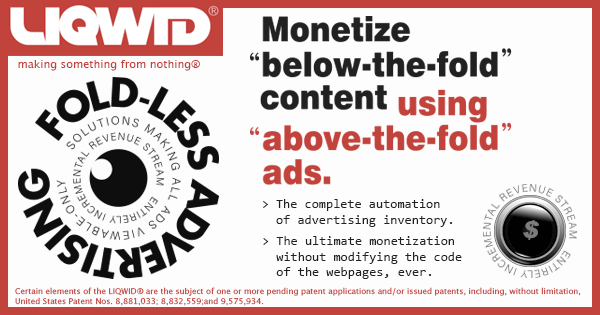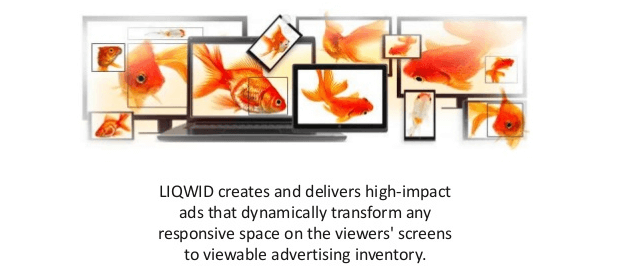* – This article has been archived and is no longer updated by our editorial team –
LIQWID is an award-winning, ad broadcasting technology that, via its original library, injects display, skins, and video ads into the viewport of the viewer’s browser programmatically, without the use of manually predefined in the webpages ad slots. Below is our recent interview with Nikolai Mentchoukov, CEO at LIQWID:

Q: Tell us please about your brand LIQWID?
A: We provide publishers with an easy and entirely automated monetization option based exclusively on the virtually positioned ads targeted to the specific parts of the content or a specific logic and rendered only when it’s scrolled in view and only when the ad can be viewable by humans. In just a few minutes digital publishers of any scale can be enabled for an entirely incremental revenue stream via programmatic and traditional media demand, without any changes to the existing websites and with no technical expertise required. LIQWID essentially enables the market to buy, sell, and run only 100% viewable ads without any disruption to the viewer’s experience, eliminating the concept of “below-the fold”.
Q: Most publishers using Google DFP as a primary monetization platform, why do you think they need LIQWID?
A: Many think of a web page as the requested HTML document regardless of length and complexity of the rendered interactive content. But from a viewer’s standpoint, a page is whatever is currently in view at a time.
DFP-based market of predefined in the code of the page inventory transacts at the point of the Page Load, and with Prebid even before that. That approach is naturally forcing to limit the number of ad slots defined on the entire HTML document as a “webpage” and position them preferably on the top of the page where they presumably have more chances to be viewable at the point of the page being rendered.
As viewers scroll, even as long as on so called lazy-scroll or infinite-scroll pages, they are essentially turning the page to look at new content and of course the ads disappear as the page is scrolled (turned). This scrolling of content is what creates the all-equally-valuable viewable market opportunities. And because such opportunities are created and managed by the LIQWID ad.Inject engine programmatically, the “After the Page Load” Market is based entirely on viewable-only ad opportunities for both, direct campaigns and programmatic programs. And in the programmatic space, a new bidding auction starts for each individual viewable opportunity.
By keeping only slots that Google recommends via their policies as the “above-the-fold” (ATF) inventory transacting at the point of the “page load,” publishers are enabled to monetize the rest of the content with ultimate effectiveness managed programmatically by LIQWID ad.Inject technology.
The publisher community significantly increases the premium inventory potential while having not more than one or two ads on the screen at any given time that can be reliably managed and not subject to human error.
Q: What is Fold-less advertising?
A: The traditional approach is based on a process flow whereby the ad slot is manually predefined in the code/markup of the webpage first and then filled with the ad when the page is loaded. With the LIWQID ad.Inject process, the ad slot exists in a form of a “virtual board”, where the logic and configuration are saved within the ad Placement parameters rather than on the publisher’s page. The ad manages its position and appearance by creating its custom markup and then is rendered only based on required conditions.
LIQWID enables digital publishers for the complete automation of advertising inventory without modifying the code of the webpages, ever, ultimately maximizing the viewable impression opportunities created and managed on the viewer’s screen programmatically. With LIQWID, all impressions are created equal — the Fold is no more.
 Recommended: Fluzcoin – Intelligent Retail Cryptocurrency That Ensures Fast Transaction Speeds With Zero Transaction Costs
Recommended: Fluzcoin – Intelligent Retail Cryptocurrency That Ensures Fast Transaction Speeds With Zero Transaction Costs
Q: Please tell us about the ad.Inject and the ad.Inject Library, how does this works?
A: Digital content is becoming more creative and complex in its technical implementation. It’s also becoming responsive and longer on a myriad of different screens and devices, it looks different for each user experience. The ad.Inject Library is essentially a library of presets that are programmed to inject additional markup and stylesheets needed to render ads and manage their positioning and appearance within a custom creative webpage design, using single-word placement parameters – a perfect tool to monetize infinite-scroll and lazy-loading pages, responsive layouts, long listings, long articles and rails, even the content of the footer – all based on the ultimate viewability on desktops, mobile and tablets. It allows for a precisely managed way to accommodate existing content even with very sophisticated layouts. Publishers can convert the unused or previously considered undesirable or below-the-fold space into the most premium viewable-only advertising inventory automatically with no changes to the website, and enhance their site viewability rating. The ad placements will create and clone themselves intelligently based on the opportunities determined on each individual viewer’s screen, maximizing the revenue potential.
Q: Does Viewable Impression metric still apply with evolving Fold-less advertising methodology?
A: The Viewable Impression metric technology originally was developed with the goal to overcome a real limitation of the architecture relying on the manually predefined ad inventory. The idea was to deliver ads only when the predefined in the code of the webpage ad slot is located or scrolled in view.
The reality of the market competition between ad tech players has added a tweak into the original concept and today Viewable Impression is associated primarily with the Verification services utilizing the viewable impression methodology for reporting data instead, while the ad delivery process is happening irrespective to the viewability criteria of each individual ad slot. Also, popular Prebid solution allows to present for bidding impression opportunities from more than one ad slot simultaneously regardless of their location on the page and before it can be determined. So, some of the paid for and delivered ads will be viewable and some not and the history will show if this equation is built into the price, as some may believe.
With the Fold-less approach the order of events is different and the opportunity for viewable ad is determined first and only then ad delivery starts. So, the entire inventory is by definition viewable-only, and verification cannot be applied in its current meaning as it is already pre-occurred. It seems that the Viewable Ad Opportunity is what represent the product we enable the market to buy and sell and a relevant to that metric would be logical to use, while “viewable impression” getting back its traditional meaning of just “impression” — impression on a human eye.
Q: What benefits Fold-less ad delivery technology brings to advertising ecosystem and players?
A: The Automated inventory approach maximizes the opportunities while ensuring that no more than one or two ads are located on the screen at any time. Placements can pass events to each other, providing a managed way to maximize the revenue potential without any disruption to the viewer’s experience.
If there is no bid that meets a price, then no ad will be injected with no impact to the content since there is no ad slot to be filled.
Unlike Prebid and common “above-the-fold” and “below-the-fold” ad units, LIQWID ad.Inject importantly initiates a bidding process only at the time of the programmatically determined and reliable viewable opportunity, based on the ad size and other specific criteria.
At the same time the automated inventory approach minimizes human error potential and illuminates the need in modifying the code of the content pages. The inventory considered as premium becomes a norm and all impression opportunities presented for transaction have equal value.
Q: In respect to the Coalition for Better Ads conclusions, do you think the ads should be smaller or bigger?
A: I think they should be an integral part of the interactive content. Nobody shovels banners of the same size in all print magazine articles. The ads reside on a separate page next to content page that make it represent 50% of the viewer’s experience. People like these ads and buying magazines where sometimes more advertising content then editorial. Nobody complains that TV commercial covers 100% of the screen. It is more complex than bigger and smaller, and most importantly the production value of the ads makes the difference. Arguably any poorly designed ad would disrupt the content and trigger a desire to rid of it – who wants to put ad blocker during Superball?
In any instance publishers should not be dictated on how and where and what size ads they should or should not use – it is their content and the market will help them to determine what works best for their audience and bottom line. All we, ad tech players, need to do is to provide them with the tools that help to increase their creative pallet and flexibility.
Q: Tell us what makes LIQWID unique?
A: These days people think of online ads as boring banners predefined in the markup of the pages at the same location on most websites, regardless of the design and layout of the content. LIQWID ad.Inject allows publishers complete control on which type of ads can be injected into any specific part of the scrolled, in-view content, and publishers are now enabled to manage monetization of these dynamically created, on-the-viewer’s-screen inventory opportunities via direct sales or programmatically with no limitation to the creative formats. Proven, in-practice ad.Inject library allows for ultimate creativity in terms of dynamic viewable inventory creation with no limitation to the placements or units ideas. With LIQWID, the internet user experience is closer to a magazine where advertising lives with the content in harmony as a stand-alone content by itself. Nobody is trying to strip ads from the magazines or to install adblock.
 Recommended: Data Theorem’s Mission Is To Analyze And Secure Any Modern Application – Anytime And Anywhere
Recommended: Data Theorem’s Mission Is To Analyze And Secure Any Modern Application – Anytime And Anywhere
Q: Do you think Programmatic will completely illuminate the need for publishers in direct sales?
A: Of coarse not. It may seem that way today because it is hottest area of investment, development and related journalism these days. But it is also, like everything else has its limitations. No doubt the processes will be optimized, but brands and creative agencies have many more needs beyond the programmatic world and there is no reason for the publishers to stop selling direct – what if someone call directly?
Q: Tell us how LIQWID began and what some of the highlights have been.
A: We, my partner Jim Rowan, and me founded LIQWID in 2010. The continuing, 20-year discussion on what can be considered as a premium offering in the online medium and how and why it should be different from traditional print advertising models influenced our idea and challenge to create and offer to the market a totally new structure for content and advertising on the Internet. On the surface, there is a main difference that was obvious – nobody sells the same size leaderboards or banner boxes by shoveling them right into the auditorium of magazine articles in the same location on every page. So here are we are today, LIQWID is a global provider of digital viewable inventory via an array of technological solutions and advertising formats enabling the market to sell, buy, and run premium ads and monetize creative web design easier than with a banner using a common ad server.
Q: What is next for LIQWID?
A: Today, publishers are being forced to limit their advertising inventory to locations at the top of the webpage, considered as “above the fold”, because they arguably have a better opportunity to be viewable when the page is loaded. This obviously is a tricky concept, as the “fold” will be different on different screens and each user can resize the browser window. Once the webpage is scrolled, everything that was initially in view, including the “above the fold” ads, leaves the viewport of the browser, and the content that was located initially “below the fold” will then come into view with no opportunity to monetize with advertising. Websites concerned with their “viewability ratings” are being forced to reduce the number of “below the fold” ad slots. This is challenging for publishers, but ironically, it is equally challenging to advertisers and creates an additional expense associated with “verification” which informs essentially on what has already happened with no opportunity to make something better.
Well, an old saying has been confirmed: any great new thing is most likely a forgotten old one. With LIQWID, publishers can finally start pricing, structuring and selling advertising the same way they have in traditional media for the last 50 years. Agencies will be enabled to have a bigger pallet than a banner, so we’ll see the superball or magazine quality ads on the digital properties. Meanwhile we’ll keep making all impressions presented for programmatic viewable-only and materially increase the viewable premium inventory footprint for publishers.
Activate Social Media:


